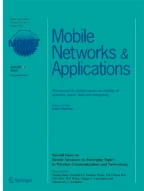242Accesses
Abstract
In Cognitive Radio (CR) networks, Call Admission Control (CAC) is a key enabling technique to ensure Quality-of-Service (QoS) provisioning for Secondary Users (SUs). CAC decisions are usually made based on the current traffic volume in the system. However, in CR networks, the system state of channel utilization can only be partially observed through spectrum sensing. The presence of sensing error may mislead the CAC strategy to make an inefficient or even incorrect decision. To achieve QoS provisioning in CR networks, a practical CAC strategy should have in-built functionality to deal with the inaccuracy of sensing results. This paper is motivated to construct a cross-layer optimization framework, in which the parameters of CAC strategy and spectrum sensing scheme are simultaneously tuned to minimize the dropping rate while satisfying the requirements of both blocking rate and interference threshold. After introducing a multiple-stair Markov model to approximate the non-memoryless state transitions, the cross-layer optimization is modelled as a non-linear programming problem. The method of branch-and-bound is employed to solve the problem, where five components are involved: problem selection, reformulation linear technique, simplex method, local search and sub-problem generation. Extensive simulations are carried out to evaluate the proposed CAC strategy. The simulation results show that our CAC strategy significantly outperforms two traditional strategies. The dropping rate in our strategy is considerably reduced. Meanwhile, the blocking rate and the interference probability strictly coincide with the constraints.
This is a preview of subscription content,log in via an institution to check access.
Access this article
Subscribe and save
- Get 10 units per month
- Download Article/Chapter or eBook
- 1 Unit = 1 Article or 1 Chapter
- Cancel anytime
Buy Now
Price includes VAT (Japan)
Instant access to the full article PDF.












Similar content being viewed by others
Notes
Here, the time durationts does not always equal to the sensing time of each channel. For instance, in [12], channels are divided into batches. Channels of a same patch are sensed simultaneously. If there aren patches, the exact sensing time for each individual channel is given by\(\frac{t_s}{n}\).
Note that,d = − 1 means that the new SUs is admitted. In this situation, parameterd should be reexplained as the change of the number of SUs, but not the number of dropped SUs.
References
Akyildiz IF, Lee WY, Vuran MC, Mohantly S (2006) Next generation/dynamic spectrum access/cognitive radio wireless network: a survey. Comput Networks 50(13):2127–2159
Mitola J, Maguire GQ (1999) Cognitive radio: making software radios more personal. IEEE Pers Commun 6(4):13–18
Ramjee R, Nagarajan R, Towsley D (1997) On optimal call admission control in cellular network. Wirel Netw (Springer) 3(1):29–41
Falowo OE, Chan HA (2007) Adaptive bandwidth management and joint call admission control to enhance system utilization and QoS in heterogeneous wireless networks. EURASIP J Wirel Commun Netw
Yu F, Krishnamurthy V, Leung VCM (2006) Cross-layer optimal connection admission control for variable bit rate multimedia traffic in packet. IEEE Trans Signal Process 54(2):542–555
Zhu X, Shen L (2007) Analysis of cognitive radio spectrum access with optimal channel reservation. IEEE Commun Lett 11(4):304–306
Zhang L, Liang YC, Xin Y (2007) Joint admission control and power allocation for cognitive radio networks. In: ICASSP 2007, vol 3, pp 673–676
Kim H, Shin KG (2007) Efficient discovery of spectrum opportunities with MAC-layer sensing in cognitive radio networks. IEEE Trans Mob Comput 7:533–545
Lee WY, Akyildiz IF (2008) Optimal spectrum sensing framework for cognitive radio networks. IEEE Trans Wirel Commun 7(10):3845–3857
Jia J (2008) HC-MAC: a hardware-constrained cognitive MAC for efficient spectrum management. IEEE J Sel Areas Commun 26(1):106–117
Ganesan G (2007) Cooperative spectrum sensing in cognitive radio. Part I: two user networks. IEEE Trans Wirel Commun 6(6):2204–2213
Liu Y, Yu R, Xie S (2008) Optimal cooperative sensing scheme under time-varying channel for cognitive radio networks. In: IEEE dyspan’08
Valaee S, Li B (2004) Distributed call admission control for ad hoc networks. IEEE Trans Wirel Commun 11(4):6–14
Zamat H, Natarajan B (2008) Use of dedicated broadband sensing receiver in cognitive radio. In: IEEE international conference on communications workshops, 2008. ICC workshops’08
Timed markov models.http://www.mathpages.com/HOME/kmath589/kmath589.htm
Sherali HD, Adams WP (1999) A reformulation-linearization technique for solving discrete and continuous nonconvex problems, chapter 8. Kluwer, Dordrecht
Digham F, Alouini M, Simon M (2007) On the energy detection of unknown signals over fading channels. IEEE Trans Commun 55(1):21–24
Tewfik AH, Kim M (1994) Fast positive definite linear system solvers. IEEE Trans Signal Process 42(3):572–582
Orlin JB (1996) A polynomial time primal network simplex algorithm for minimum cost flows. In: Proceedings of the seventh annual ACM-SIAM symposium on discrete algorithms, pp 474–481
Acknowledgements
The work in this paper is supported by Key Programs of NSFC with Grant No. U0635001, U0828003.
Author information
Authors and Affiliations
School of Electronic and Information Engineering, South China University of Technology, Guangzhou, China
Rong Yu, Ming Huang & Shengli Xie
Simula Research Laboratory, Fornebu, Norway
Yan Zhang
- Rong Yu
You can also search for this author inPubMed Google Scholar
- Yan Zhang
You can also search for this author inPubMed Google Scholar
- Ming Huang
You can also search for this author inPubMed Google Scholar
- Shengli Xie
You can also search for this author inPubMed Google Scholar
Corresponding author
Correspondence toRong Yu.
Rights and permissions
About this article
Cite this article
Yu, R., Zhang, Y., Huang, M.et al. Cross-Layer Optimized Call Admission Control in Cognitive Radio Networks.Mobile Netw Appl15, 610–626 (2010). https://doi.org/10.1007/s11036-009-0194-1
Published:
Issue Date:
Share this article
Anyone you share the following link with will be able to read this content:
Sorry, a shareable link is not currently available for this article.
Provided by the Springer Nature SharedIt content-sharing initiative



